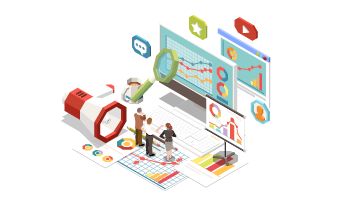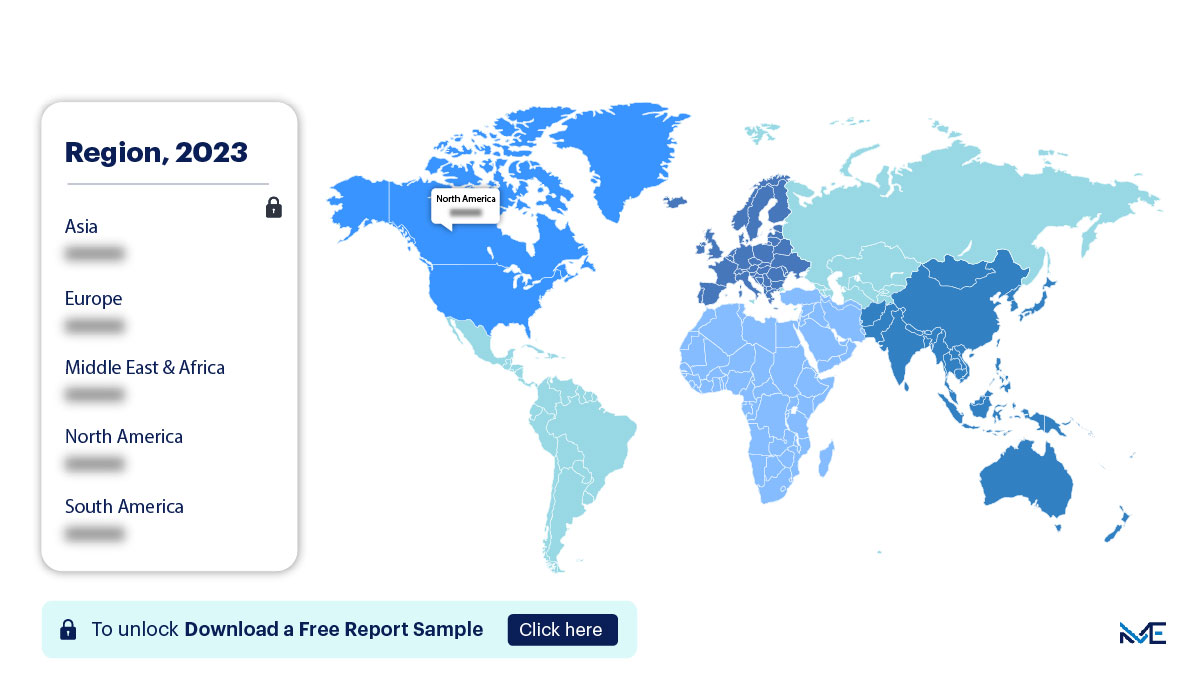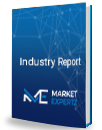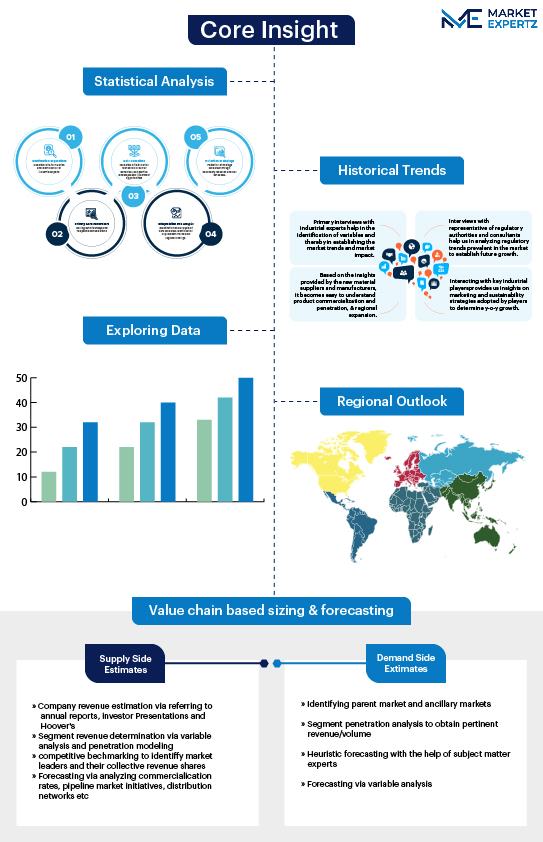Market Snapshot
| Study Period | 2019-2032 |
| Base Year | 2023 |
| Forcast Year | 2023-2032 |
| CAGR | 8.62 |


Gain accurate insights regarding the negative impacts of COVID-19 on all markets and industries
Download Sample PdfReport Overview
Of course, here are the analyses for the markets you've mentioned:
The Risk Analytics Market is projected to experience steady growth, with a projected Compound Annual Growth Rate (CAGR) of 12.89% between 2022 and 2032. The market is expected to expand by USD 57,896.21 million. The growth is driven by the increasing need for data-driven risk assessment, the surge in cybersecurity threats, and advancements in predictive analytics and AI technologies.
Risk Analytics Market Overview:
Drivers:
Moreover, the rise of big data and data-driven decision-making contributes to market growth. Risk analytics leverages data mining and predictive modeling to provide actionable insights for risk management strategies.
Trends:
Furthermore, the adoption of real-time risk monitoring supports timely risk mitigation. Real-time analytics enable businesses to monitor events and trends that can impact risk exposure.
Restraints:
Moreover, the complexity of integrating risk analytics solutions with existing systems may arise. Ensuring seamless integration and data interoperability are crucial for effective implementation.
Risk Analytics Market Segmentation By Component:
The software segment, offering risk modeling, data visualization, and predictive analytics tools, is projected to dominate the Risk Analytics Market.
Risk Analytics Market Segmentation By Deployment Mode:
The cloud-based deployment segment, providing scalability and remote access, is expected to be a significant contributor to the Risk Analytics Market.
Regional Overview:

Download the report summary now!
Request pdf Sample
North America is poised to be a major player in the global Risk Analytics Market's growth. The region's focus on data-driven decision-making, strict regulatory frameworks, and cybersecurity awareness drive the demand for risk analytics solutions.
Furthermore, Europe is experiencing growth due to factors such as the adoption of risk management strategies, the need for compliance with regulations, and the emphasis on proactive risk assessment.
Risk Analytics Market Customer Landscape:
The Risk Analytics Market serves businesses across industries seeking to enhance risk management, compliance, and strategic decision-making. Understanding the unique risk assessment needs of each industry is essential for risk analytics solution providers.
Major Risk Analytics Market Companies:
Key players in the Risk Analytics Market provide risk assessment software, predictive modeling tools, and data visualization platforms.
- IBM Corporation
- SAS Institute Inc.
- Oracle Corporation
- SAP SE
- FIS
- Moody's Analytics, Inc.
- Verisk Analytics, Inc.
- FICO
- AxiomSL
- Numerix LLC
These companies are dedicated to delivering risk analytics solutions to help businesses identify and manage potential risks.
Segment Overview:
The Risk Analytics market report provides revenue forecasts and analyses for various segments, including:
- Software
- Services
Geography Outlook:
- North America
- The United States
- Canada
- Europe
- United Kingdom
- Germany
- France
- Rest of Europe
- APAC
- China
- Japan
- India
- South America
- Brazil
- Argentina
- Middle East & Africa
- United Arab Emirates
- South Africa
- Rest of Middle East & Africa
TABLE OF CONTENTS: GLOBAL Risk Analytics MARKET
Chapter 1. MARKET SYNOPSIS
1.1. Market Definition
1.2. Research Scope & Premise
1.3. Methodology
1.4. Market Estimation Technique
Chapter 2. EXECUTIVE SUMMARY
2.1. Summary Snapshot, 2016 – 2027
Chapter 3. INDICATIVE METRICS
3.1. Macro Indicators
Chapter 4. Risk Analytics MARKET SEGMENTATION & IMPACT ANALYSIS
4.1. Risk Analytics Segmentation Analysis
4.2. Industrial Outlook
4.3. Price Trend Analysis
4.4. Regulatory Framework
4.5. Porter’s Five Forces Analysis
4.5.1. Power Of Suppliers
4.5.2. Power Of Buyers
4.5.3. Threat Of Substitutes
4.5.4. Threat Of New Entrants
4.5.5. Competitive Rivalry
Chapter 5. Risk Analytics MARKET BY component landscape
SIGHTS & TRENDS
5.1. Segment 1 Dynamics & Market Share, 2019 & 2027
5.2 Solution
5.2.1. Market Estimates And Forecast, 2016 – 2027 (USD Million)
5.2.2. Market Estimates And Forecast, By Region, 2016 – 2027 (USD Million)
5.3 Service
5.3.1. Market Estimates And Forecast, 2016 – 2027 (USD Million)
5.3.2. Market Estimates And Forecast, By Region, 2016 – 2027 (USD Million)
Chapter 6. Risk Analytics MARKET BY deployment INSIGHTS & TRENDS
6.1. Segment 2 Dynamics & Market Share, 2019 & 2027
6.2 On-premise
6.2.1. Market Estimates And Forecast, 2016 – 2027 (USD Million)
6.2.2. Market Estimates And Forecast, By Region, 2016 – 2027 (USD Million)
6.3 Cloud
6.3.1. Market Estimates And Forecast, 2016 – 2027 (USD Million)
6.3.2. Market Estimates And Forecast, By Region, 2016 – 2027 (USD Million)
Chapter 7. Risk Analytics MARKET REGIONAL OUTLOOK
7.1. Risk Analytics Market Share By Region, 2019 & 2027
7.2. NORTH AMERICA
7.2.1. North America Risk Analytics Market Estimates And Forecast, 2016 – 2027, (USD Million)
7.2.2. North America Risk Analytics Market Estimates And Forecast By Segment 1, 2016 –2027, (USD Million)
7.2.3. North America Risk Analytics Market Estimates And Forecast By Segment 2, 2016 –2027, (USD Million)
7.2.4. North America Risk Analytics Market Estimates And Forecast By Segment 3, 2016 –2027, (USD Million)
7.2.5. U.S.
7.2.5.1. U.S. Risk Analytics Market Estimates And Forecast, 2016 – 2027, (USD Million)
7.2.5.2. U.S. Risk Analytics Market Estimates And Forecast By Segment 1, 2016 –2027, (USD Million)
7.2.5.3. U.S. Risk Analytics Market Estimates And Forecast By Segment 2, 2016 –2027, (USD Million)
7.2.5.4. U.S. Risk Analytics Market Estimates And Forecast By Segment 3, 2016 –2027, (USD Million)
7.2.6. CANADA
7.2.6.1. Canada Risk Analytics Market Estimates And Forecast, 2016 – 2027, (USD Million)
7.2.6.2. Canada Risk Analytics Market Estimates And Forecast By Segment 1, 2016 –2027, (USD Million)
7.2.6.3. Canada Risk Analytics Market Estimates And Forecast By Segment 2, 2016 –2027, (USD Million)
7.2.6.4. Canada Risk Analytics Market Estimates And Forecast By Segment 3, 2016 –2027, (USD Million)
7.3. EUROPE
7.3.1. Europe Risk Analytics Market Estimates And Forecast, 2016 – 2027, (USD Million)
7.3.2. Europe Risk Analytics Market Estimates And Forecast By Segment 1, 2016 –2027, (USD Million)
7.3.3. Europe Risk Analytics Market Estimates And Forecast By Segment 2, 2016 –2027, (USD Million)
7.3.4. Europe Risk Analytics Market Estimates And Forecast By Segment 3, 2016 –2027, (USD Million)
7.3.5. GERMANY
7.3.5.1. Germany Risk Analytics Market Estimates And Forecast, 2016 – 2027, (USD Million)
7.3.5.2. Germany Risk Analytics Market Estimates And Forecast By Segment 1, 2016 –2027, (USD Million)
7.3.5.3. Germany Risk Analytics Market Estimates And Forecast By Segment 2, 2016 –2027, (USD Million)
7.3.5.4. Germany Risk Analytics Market Estimates And Forecast By Segment 3, 2016 –2027, (USD Million)
7.3.6. FRANCE
7.3.6.1. France Risk Analytics Market Estimates And Forecast, 2016 – 2027, (USD Million)
7.3.6.2. France Risk Analytics Market Estimates And Forecast By Segment 1, 2016 –2027, (USD Million)
7.3.6.3. France Risk Analytics Market Estimates And Forecast By Segment 2, 2016 –2027, (USD Million)
7.3.6.4. France Risk Analytics Market Estimates And Forecast By Segment 3, 2016 –2027, (USD Million)
7.3.7. U.K.
7.3.7.1. U.K. Risk Analytics Market Estimates And Forecast, 2016 – 2027, (USD Million)
7.3.7.2. U.K. Risk Analytics Market Estimates And Forecast By Segment 1, 2016 –2027, (USD Million)
7.3.7.3. U.K. Risk Analytics Market Estimates And Forecast By Segment 2, 2016 –2027, (USD Million)
7.3.7.4. U.K. Risk Analytics Market Estimates And Forecast By Segment 3, 2016 –2027, (USD Million)
7.4. ASIA-PACIFIC
7.4.1. Asia Pacific Risk Analytics Market Estimates And Forecast, 2016 – 2027, (USD Million)
7.4.2. Asia Pacific Risk Analytics Market Estimates And Forecast By Segment 1, 2016 –2027, (USD Million)
7.4.3. Asia Pacific Risk Analytics Market Estimates And Forecast By Segment 2, 2016 –2027, (USD Million)
7.4.4. Asia Pacific Risk Analytics Market Estimates And Forecast By Segment 3, 2016 –2027, (USD Million)
7.4.5. CHINA
7.4.5.1. China Risk Analytics Market Estimates And Forecast, 2016 – 2027, (USD Million)
7.4.5.2. China Risk Analytics Market Estimates And Forecast By Segment 1, 2016 –2027, (USD Million)
7.4.5.3. China Risk Analytics Market Estimates And Forecast By Segment 2, 2016 –2027, (USD Million)
7.4.5.4. China Risk Analytics Market Estimates And Forecast By Segment 3, 2016 –2027, (USD Million)
7.4.6. INDIA
7.4.6.1. India Risk Analytics Market Estimates And Forecast, 2016 – 2027, (USD Million)
7.4.6.2. India Risk Analytics Market Estimates And Forecast By Segment 1, 2016 –2027, (USD Million)
7.4.6.3. India Risk Analytics Market Estimates And Forecast By Segment 2, 2016 –2027, (USD Million)
7.4.6.4. India Risk Analytics Market Estimates And Forecast By Segment 3, 2016 –2027, (USD Million)
7.4.7. JAPAN
7.4.7.1. Japan Risk Analytics Market Estimates And Forecast, 2016 – 2027, (USD Million)
7.4.7.2. Japan Risk Analytics Market Estimates And Forecast By Segment 1, 2016 –2027, (USD Million)
7.4.7.3. Japan Risk Analytics Market Estimates And Forecast By Segment 2, 2016 –2027, (USD Million)
7.4.7.4. Japan Risk Analytics Market Estimates And Forecast By Segment 3, 2016 –2027, (USD Million)
7.4.8. AUSTRALIA
7.4.8.1. Australia Risk Analytics Market Estimates And Forecast, 2016 – 2027, (USD Million)
7.4.8.2. Australia Risk Analytics Market Estimates And Forecast By Segment 1, 2016 –2027, (USD Million)
7.4.8.3. Australia Risk Analytics Market Estimates And Forecast By Segment 2, 2016 –2027, (USD Million)
7.4.8.4. Australia Risk Analytics Market Estimates And Forecast By Segment 3, 2016 –2027, (USD Million)
7.5. MIDDLE EAST AND AFRICA (MEA)
7.5.1. Mea Risk Analytics Market Estimates And Forecast, 2016 – 2027, (USD Million)
7.5.2. Mea Risk Analytics Market Estimates And Forecast By Segment 1, 2016 –2027, (USD Million)
7.5.3. Mea Risk Analytics Market Estimates And Forecast By Segment 2, 2016 –2027, (USD Million)
7.5.4. Mea Risk Analytics Market Estimates And Forecast By Segment 3, 2016 –2027, (USD Million)
7.6. LATIN AMERICA
7.6.1. Latin America Risk Analytics Market Estimates And Forecast, 2016 – 2027, (USD Million)
7.6.2. Latin America Risk Analytics Market Estimates And Forecast By Segment 1, 2016 –2027, (USD Million)
7.6.3. Latin America Risk Analytics Market Estimates And Forecast By Segment 2, 2016 –2027, (USD Million)
7.6.4. Latin America Risk Analytics Market Estimates And Forecast By Production Process, 2016 –2027, (USD Million)
7.6.5. Latin America Risk Analytics Market Estimates And Forecast By Segment 3, 2016 –2027, (USD Million)
Chapter 8. COMPETITIVE LANDSCAPE
8.1. Market Share By Manufacturers
8.2. Strategic Benchmarking
8.2.1. New Product Launches
8.2.2. Investment & Expansion
8.2.3. Acquisitions
8.2.4. Partnerships, Agreement, Mergers, Joint-Ventures
8.3. Vendor Landscape
8.3.1. North American Suppliers
8.3.2. European Suppliers
8.3.3. Asia-Pacific Suppliers
8.3.4. Rest Of The World Suppliers
Chapter 9. COMPANY PROFILES
9.1 IBM Corporation
9.1.1. Company Overview
9.1.2. Financial Performance
9.1.3. Product Insights
9.1.4. Strategic Initiatives
9.2 SAP SE
9.2.1. Company Overview
9.2.2. Financial Performance
9.2.3. Product Insights
9.2.4. Strategic Initiatives
9.3 AxiomSL Ltd
9.3.1. Company Overview
9.3.2. Financial Performance
9.3.3. Product Insights
9.3.4. Strategic Initiatives
9.4 Orcale Corporation
9.4.1. Company Overview
9.4.2. Financial Performance
9.4.3. Product Insights
9.4.4. Strategic Initiatives
9.5 SAS Institute Inc
9.5.1. Company Overview
9.5.2. Financial Performance
9.5.3. Product Insights
9.5.4. Strategic Initiatives
9.6 Company 6
9.6.1. Company Overview
9.6.2. Financial Performance
9.6.3. Product Insights
9.6.4. Strategic Initiatives
9.7 Company 7
9.7.1. Company Overview
9.7.2. Financial Performance
9.7.3. Product Insights
9.7.4. Strategic Initiatives
9.8 Company 8
9.8.1. Company Overview
9.8.2. Financial Performance
9.8.3. Product Insights
9.8.4. Strategic Initiatives
9.9 Company 9
9.9.1. Company Overview
9.9.2. Financial Performance
9.9.3. Product Insights
9.9.4. Strategic Initiatives
9.10 Company 10
9.10.1. Company Overview
9.10.2. Financial Performance
9.10.3. Product Insights
9.10.4. Strategic Initiatives
RESEARCH METHODOLOGY
A research methodology is a systematic approach for assessing or conducting a market study. Researchers tend to draw on a variety of both qualitative and quantitative study methods, inclusive of investigations, survey, secondary data and market observation.
Such plans can focus on classifying the products offered by leading market players or simply use statistical models to interpret observations or test hypotheses. While some methods aim for a detailed description of the factors behind an observation, others present the context of the current market scenario.
Now let’s take a closer look at the research methods here.
Secondary Research Model
Extensive data is obtained and cumulated on a substantial basis during the inception phase of the research process. The data accumulated is consistently filtered through validation from the in-house database, paid sources as well reputable industry magazines. A robust research study requires an understanding of the overall value chain. Annual reports and financials of industry players are studied thoroughly to have a comprehensive idea of the market taxonomy.
Primary Insights
Post conglomeration of the data obtained through secondary research; a validation process is initiated to verify the numbers or figures. This process is usually performed by having a detailed discussion with the industry experts.
However, we do not restrict our primary interviews only to the industry leaders. Our team covers the entire value chain while verifying the data. A significant number of raw material suppliers, local manufacturers, distributors, and stakeholders are interviewed to make our findings authentic. The current trends which include the drivers, restraints, and opportunities are also derived through the primary research process.
Market Estimation
The market estimation is conducted by analyzing the data collected through both secondary and primary research. This process involves market breakdown, bottom-up and top- down approach.
Moreover, while forecasting the market a comprehensive statistical time series model is designed for each market. Macroeconomic indicators are considered to understand the current trends of the market. Each data point is verified by the process of data triangulation method to arrive at the final market estimates.
Final Presentation
The penultimate process results in a holistic research report. The study equips key industry players to undertake significant strategic decisions through the findings. The report encompasses detailed market information. Graphical representations of the current market trends are also made available in order to make the study highly comprehensible for the reader.
Personalized Business Report Tailored to Your Requirements
- Our expert analysts collaborate directly with you to comprehend your specific needs.
- Get data on regions, segments, competitors, and vendors of your choice.
- Information is presented in alignment with your exact preferences and formatting.
Free Sample Report
"Find new revenue generation opportunities"

